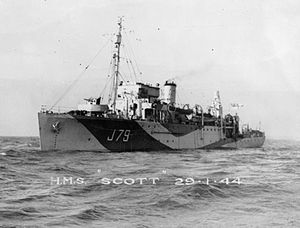
HMS Ivanhoe was an I-class destroyer built for the Royal Navy in the mid-1930s. During the Spanish Civil War of 1936–1939, the ship enforced the arms blockade imposed by Britain and France on both sides as part of the Mediterranean Fleet. Before the start of World War II, the ship was modified so that she could be used to lay mines by removing some of her armament. Ivanhoe was transferred to Western Approaches Command shortly after the war began and helped to sink one German submarine in October 1939. She was converted to a minelayer while undergoing a refit in November–December and laid minefields in German coastal waters as well as anti-submarine minefields off the British coast until she was reconverted back to her destroyer configuration in February 1940. Ivanhoe reverted to her minelaying role during the Norwegian Campaign in April 1940 and then laid a number of minefields off the Dutch coast during the Battle of the Netherlands in May. The ship participated in the Dunkirk evacuation until she was badly damaged by German aircraft on 1 June. On her first minelaying mission after her repairs were completed, she struck a German mine and had to be scuttled on 1 September 1940 during the Texel Disaster.
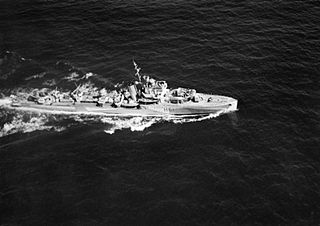
HMS Express was an E-class minelaying destroyer built for the Royal Navy in the early 1930s. Although assigned to the Home Fleet upon completion, the ship was attached to the Mediterranean Fleet in 1935–36 during the Abyssinia Crisis. During the Spanish Civil War of 1936–1939, she spent considerable time in Spanish waters, enforcing the arms blockade imposed by Britain and France on both sides of the conflict.

A minelayer is any warship, submarine, military aircraft or land vehicle deploying explosive mines. Since World War I the term "minelayer" refers specifically to a naval ship used for deploying naval mines. "Mine planting" was the term for installing controlled mines at predetermined positions in connection with coastal fortifications or harbor approaches that would be detonated by shore control when a ship was fixed as being within the mine's effective range.

The Halcyon class was a class of 21 oil-fired minesweepers built for the British Royal Navy between 1933 and 1939. They were given traditional small ship names used historically by the Royal Navy and served during the Second World War.

HMS Abdiel was an Abdiel-class minelayer that served with the Royal Navy during World War II. She served with the Mediterranean Fleet (1941), Eastern Fleet (1942), Home Fleet (1942–43), and the Mediterranean Fleet (1943). Abdiel was sunk by German mines in Italy's Taranto harbour in 1943. Although designed as a fast minelayer her speed and capacity made her suitable for employment as a fast transport.

HMS Adventure, pennant number M23, was an Adventure-class minelaying cruiser of the Royal Navy built in the 1920s that saw service during the Second World War. Her commander between 1928 and 1929 was the future First Sea Lord John H. D. Cunningham. Laid down at Devonport in November 1922 and launched in June 1924, Adventure was the first vessel built for service as a minelayer; she was also the first warship to use diesel engines, which were used for cruising. Adventure first joined the Atlantic Fleet, then was transferred to the China Station in 1935. In World War II, the ship was damaged in 1941 and 1944, and was converted to a landing craft repair in 1944. In 1945 Adventure was reduced to reserve and in 1947 she was sold and broken up for scrap.

The Northern Barrage was the name given to minefields laid by the British during World War II to restrict German access to the Atlantic Ocean. The barrage stretched from the Orkney to the Faroe Islands and on toward Iceland. Mines were also laid in the Denmark Strait, north of Iceland.

HMS Esk was an E-class destroyer built for the Royal Navy in the early 1930s. She was designed to be easily converted into a fast minelayer by removing some guns and her torpedo tubes. Although assigned to the Home Fleet upon completion, the ship was attached to the Mediterranean Fleet in 1935–36, during the Abyssinia Crisis. During the Spanish Civil War of 1936–1939, she spent considerable time in Spanish waters, enforcing the arms blockade imposed by Britain and France on both sides of the conflict. Esk was converted to a minelayer when World War II began in September 1939, and spent most of her time laying mines. During the Norwegian Campaign of April–June 1940, the ship laid mines in Norwegian territorial waters before the Germans invaded, but was recalled to home waters to resume her minelaying duties in early May. During one such sortie, Esk was sunk during the Texel Disaster on the night of 31 August 1940, when she ran into a newly laid German minefield.

HMS Niger was a Halcyon-class minesweeper of the Royal Navy. She was launched in 1936 and was sunk during the Second World War. On 5 July 1942, the vessel sailed into a minefield while escorting Convoy QP 13 and struck one of the mines, later sinking with only eight survivors.
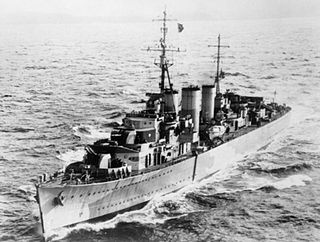
HMS Welshman was an Abdiel-class minelayer of the Royal Navy, launched in September 1941. During World War II she served with the Home Fleet carrying out minelaying operations, before being transferred to the Mediterranean Fleet in mid-1942 for the Malta Convoys. She also saw service during Operation Torch. The ship was torpedoed and sunk off Tobruk by the German submarine U-617 on 1 February 1943, with the loss of 157 lives.

HMS Apollo was an Abdiel-class minelayer of the Royal Navy, the eighth RN ship to carry the name. She served with the Home Fleet during World War II, taking part in the Normandy Landings before being transferred to the British Pacific Fleet. Put into reserve in 1946, she was recommissioned in 1951, serving until 1961, and was sold for scrapping in 1962.
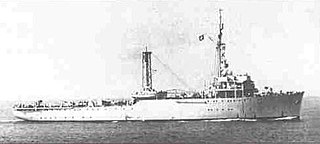
The Yugoslav minelayer Zmaj was built in Weimar Germany for the Royal Yugoslav Navy in the late 1920s. She was built as a seaplane tender, but does not appear to have been much used in that role and was converted to a minelayer in 1937. Shortly before the Axis invasion of Yugoslavia in April 1941 during the Second World War, she laid minefields along the Dalmatian coast, perhaps inadvertently leading to the sinking of two Yugoslav passenger ships. Slightly damaged by Italian dive bombers and then captured by the Italians during the invasion, she was soon handed over to the Germans. While in their service the ship was renamed Drache, had her anti-aircraft (AA) armament improved, and was used as a seaplane tender and later as a troop transport. In the latter role she participated in over a dozen convoys between the Greek port of Piraeus and the Greek island of Crete between December 1941 and March 1942.

HMS Southern Prince was a motor ship that was built in 1929 as the refrigerated cargo ship Southern Prince. She was commissioned into the Royal Navy in 1940 as a minelayer. She became a headquarters ship and then an accommodation ship in 1944, was a fleet training ship in 1945, and returned to civilian trade in 1946. In 1947 she was sold to Italian owners who had her refitted as a passenger ship and renamed her Anna C. From 1952 she was a cruise ship. She was scrapped in 1972.
HMS Teviot Bank was a Bank Line steamship that was built in England in 1938 as the cargo ship Teviotbank. In the Second World War she was a Royal Navy auxiliary minelayer. By 1956 a Panamanian company had bought her and renamed her Nella. She was scrapped in Italy in 1971.

HMS Abdiel was a Marksman-class flotilla leader of the Royal Navy, built by Cammell Laird during the First World War. She was converted to a minelayer during construction, commissioning during 1916, and served at the Battle of Jutland. Following the end of the war, Abdiel served in the Baltic during the Russian Civil War. She was sold for scrap in 1936.
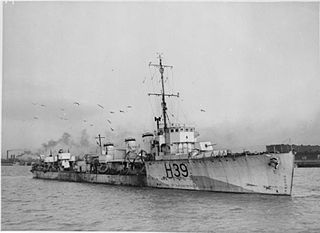
HMS Tarpon was a Royal Navy R-class destroyer constructed and operational in the First World War. She is named after the large fish Tarpon; one species of which is native to the Atlantic, and the other to the Indo-Pacific Oceans. Tarpon was built by the shipbuilders John Brown & Company at their Clydebank shipyard and was launched in March 1917 and entered service in April that year.
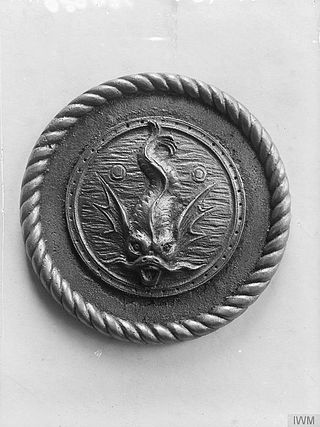
HMS Telemachus was a R-class destroyer of the British Royal Navy that took part in the First World War. She was built in 1916–1917 by the Scottish shipbuilder John Brown at their Clydebank shipyard. Telemachus was modified to serve as a minelayer, laying minefields in the German Bight and English Channel to restrict the operation of German submarines. The ship survived the war and was sold for scrap in 1927.

HMS Sharpshooter was a Halcyon-class minesweeper of the British Royal Navy. Built at Devonport Dockyard, Sharpshooter was completed in 1937. She served through the Second World War, acting both in her designed role as minesweeper and as a convoy escort, escorting several Arctic convoys. She took part in the evacuation from Dunkirk in 1940, and sank the German submarine U-655 in 1942.

HMS Princess Margaret was a minelayer operated by the British Royal Navy during and after the First World War. She was built by the Scottish shipbuilder William Denny for the Canadian Pacific Railway as a liner to serve on the Pacific West Coast, and as such was powered by geared steam turbines, giving a speed of 23 knots.
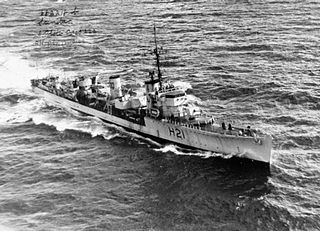
HMS Scimitar was an S-class destroyer which served with the Royal Navy and the first ship in the Royal Navy named after the Scimitar, an Arabian backsword or sabre with a curved blade. She served in both World Wars and following a National Savings campaign in 1942 she was adopted by the civil community of Pershore, Worcestershire.
